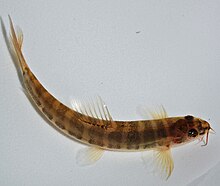
The barred knifejaw, also known as the striped beakfish or rock bream, is a species of marine ray-finned fish, from the family Oplegnathidae. It is commonly native to the north-western Pacific Ocean, though a smattering of records exist from other localities in the eastern Pacific such as Hawaii and Chile. Recently introduced – likely via ballast water – in the central Mediterranean, it is found very rarely from Malta to the northern Adriatic. There is no listed conservation status for this species, though it is farmed for consumption and angling in many Asian countries suggesting it is common.

The banded kōkopu is a galaxiid of the genus Galaxias, found only in New Zealand, including the Chatham and Stewart / Rakiura islands. It commonly grows to 20–25 cm, but has been recorded growing to around 30 cm. Juvenile banded kōkopu are good climbers and can climb up waterfalls and other vertical surfaces by moving into the splash zone and wriggling up the surface, using the water surface tension and their large downturned fins for grip.

Nemacheilus is a genus of stone loaches native to Asia.

The stone loach is a European species of fresh water ray-finned fish in the family Nemacheilidae. It is one of nineteen species in the genus Barbatula. Stone loaches live amongst the gravel and stones of fast flowing water where they can search for food. The most distinctive feature of this small fish is the presence of barbels around the bottom jaw, which they use to detect their invertebrate prey. The body is a mixture of brown, green and yellow.
The Blind cave loach is a species of troglobitic stone loach endemic to Thailand. It is only known from one subterranean stream in the Sai Yok Noi cave, which also is inhabited by Pterocryptis buccata. The blind cave loach has no eyes and lacks pigmentation. It grows to 6.8 cm (2.7 in) SL. Despite its common name, there are several other species of blind cave-living loaches.

Schistura semiarmata is a species of stone loach in the genus Schistura. It is found in the Indian states of Karnataka, Kerala, and Tamil Nadu and, at least based on some sources, in Pakistan. It grows to 5.6 cm (2.2 in) SL. It is a very common species inhabiting high altitude streams with hard bottom. It is sometimes used as an aquarium fish.
Nemacheilus anguilla, the eel loach, is a species of ray-finned fish in the genus Nemacheilus which is endemic to the Western Ghats in southern India. It occurs in streams with pebbles and with sandy substrates. It is collected for the aquarium trade but the main threat may come from pollution caused by large numbers of pilgrims which attend temples near the waters in which this species occurs.
Oxynoemacheilus hamwii, the Orontes sportive loach, is a species of ray-finned fish in the genus Oxynoemacheilus. This species is found in the headwaters of the Orontes River but is now restricted to three streams in the Turkish part of the drainage, two joining the lower Orontes in Turket and the third flowing into the Afrin River in Syria, and has been extirpated from Syria. It was described as being very common in the late 20th century, but it is sensitive to pollution and requires clear, flowing streams over mud or gravel. The drainage of the Orontes is heavily used by humans and lower rainfall in the region caused by climate change may exacerbate the threat to this species by increasing the amount of water taken from the streams by humans and by lowering the water table.

Indoreonectes keralensis is a species of ray-finned fish in the genus Indoreonectes. This small stone loach is endemic to streams in the Western Ghats of India.
Schistura kodaguensis is a species of ray-finned fish, a stone loach, in the genus Schistura. This species has been recorded from a single stream with a swift current and gravel bottom in the Cauvery River system in Karnataka, India. The specific name is derived from Kodagu District where the type specimen was collected.
Nemacheilus monilis, the spotted loach, is a species of ray-finned fish in the genus Nemacheilus which is endemic to the southern Western Ghats in the Indian states of Kerala and Tamil Nadu. It occurs in fast flowing water, even in rapids, over substrates consisting of pebbles and cobble substrates. It occasionally is collected and exported for the aquarium trade.

Nemacheilus triangularis is a species of stone loach endemic to the Western Ghats in southern Karnataka, Kerala, and Tamil Nadu, India. It is a fairly common species occurring in streams with gravel, cobbles and bedrock with some sand as the substrate. This fish grows to a length of 5.8 centimetres (2.3 in) SL and can be found in the aquarium trade.
Nemacheilus selangoricus is a species of ray-finned fish in the genus Nemacheilus. This species can be found in fast flowing forest streams with acidic water and sand-gravel substrate It occurs in the Indonesian islands of Sumatra, Bangka and Belitung as well as in the Malay Peninsula from Singapore north to Trang and Songkhla in Thailand. It is collected for the aquarium trade.
Nemacheilus stigmofasciatus, the Thuttinjet stone loach, is a species of ray-finned fish in the genus Nemacheilus which has been recorded from just one locality in the west flowing river Seethanathi at Thuttinjet in Karnataka. This locality is at an altitude of 199m above sea level and has many cascades and waterfalls in its upstream portion. The stream is dominated by the presence of pebbles and boulders with gravel and sand making up approximately 5% of the substrate.
The arrow loach is a species of ray-finned fish in the genus Nemacheilus.
The Amu-Darya stone loach is a species of ray-finned fish in the genus Nemacheilus, although it is sometimes placed in the genus Oxynoemacheilus.

Synocrossus beauforti, the barred loach, chameleon loach or chameleon botia, is a species of freshwater fish from the loach family Botiidae which is found in mainland south-east Asia.










